Discover Toronto's history as told through its plaques
2004 - Now in our 15th Year - 2019
To see what's new on this site, you can visit the Home Page
Looking at this page on a smartphone?
For best viewing, hold your phone in Landscape mode (Horizontal)
Welcome to Islington: Toronto's Village of Murals

Photo by Alan L Brown - Posted March, 2012
This entrance mural, titled Welcome to Islington: Toronto's Village of Murals is located on the north wall of the Dundas Street West bridge over Mimico Creek, just west of Islington Avenue. The Village of Islington Business Improvement Area has coordinated a collection of murals along Dundas Street West beginning at Islington Avenue and continuing west 1.1 km almost to Kipling Avenue. Below, you will find photographs of each of the murals and plaques as well as the street addresses. Note that all the street numbers ending in even numbers are on the north side of Dundas Street West, those ending in odd numbers are on the south side.
Coordinates: 43.65090, -79.52689 |
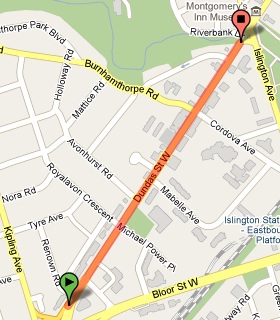 |
To see the plaques and murals, you can scroll down the page or
jump to a specific plaque in the alphabetical list below.
Aftermath
Battersby's March, 1813
Briarly - Gone But Not Forgotten
Faces of Islington
Faith of Our Fathers, 2
Fishing in Mimico Creek
Golfing in Islington
Gordon's Dairy, ca. 1940
Harold G. Shipp's "First High Flier!"
Honouring Islington's Volunteer Fire Brigade
Islington - The Way We Were - Part II
Manse Committee
Mimico Creek, ca. 1920
Old Swimming Hole
Ontario Gothic
Ordinary Folk, Extraordinary Lives
Portraits From Our Past
Prodigy
Pub With No Beer
Riding the Radials
Timeline, Islington Then and Now
Toboggan Hill
Way We Were - Islington ca 1900
Return to list of murals
Golfing in Islington
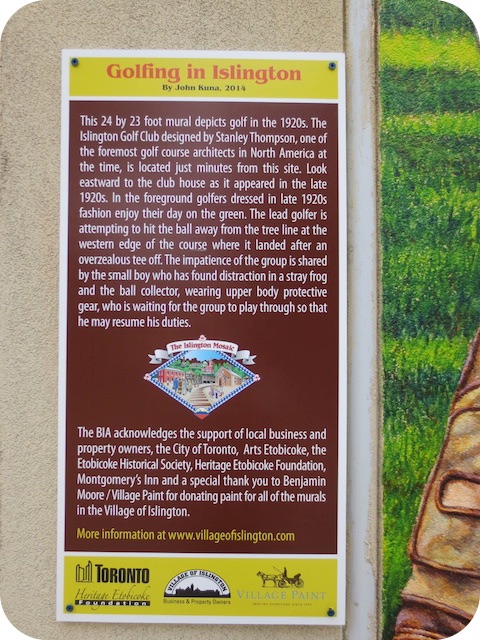
Photos by Alan L Brown - Posted May, 2015
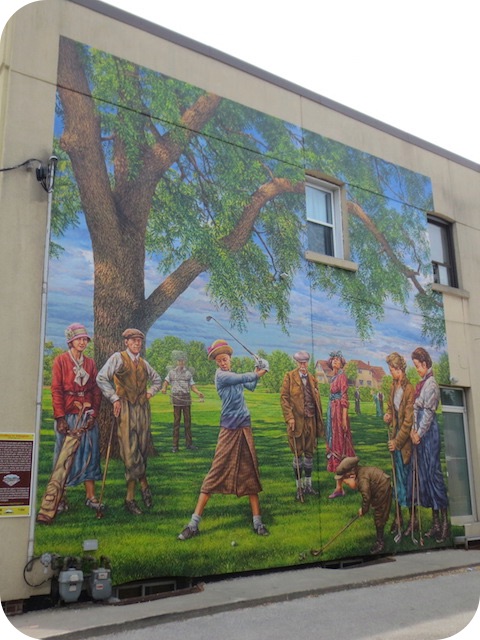
This Village of Islington mural, titled "Golfing in Islington" and painted in 2014 by John Kuna at 4866 Dundas Street West, depicts golf in the 1920s. Here's what the plaque says:
Coordinates: 43.649995 -79.527845 |
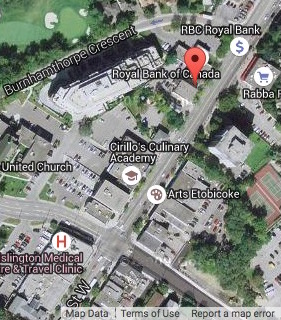 |
This 7.3 by 7.0 metre mural depicts golf in the 1920s. The Islington Golf Club designed by Stanley Thompson, one of the foremost golf course architects in North America at the time, is located just minutes from this site. Look eastward to the club house as it appeared in the late 1920s. In the foreground golfers dressed in the late 1920s fashion enjoy their day on the green. The lead golfer is attempting to hit the ball away from the tree line at the western edge of the course where it landed after an overzealous tee off. The impatience of the group is shared by the small boy who has found distraction in a stray frog and the ball collector, wearing upper body protective gear, who is waiting for the group to play through so that he may resume his duties.
Related webpages
Islington Golf Course
Stanley Thompson
The 1920s
Related Toronto plaque
Cliffside Golf Course 1931-1950
Return to list of murals
Aftermath
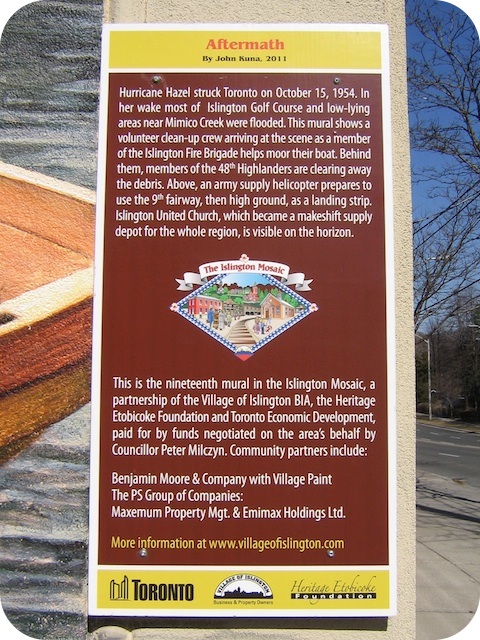
Photos by Alan L Brown - Posted March, 2012
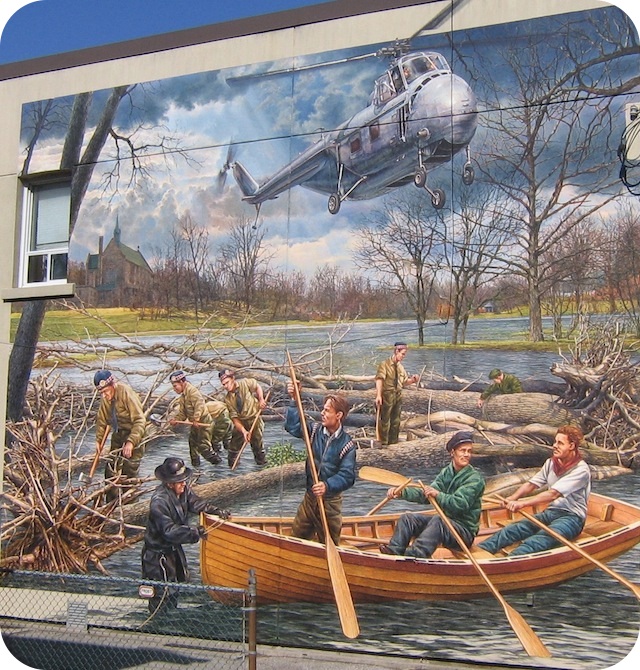
This Village of Islington mural, titled "Aftermath" and painted in 2011 by John Kuna at 4868 Dundas Street West, depicts the aftermath of Hurricane Hazel. Here's what the plaque says:
Coordinates: 43.64988 -79.52790 |
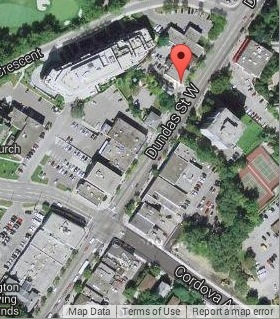 |
Hurricane Hazel struck Toronto on October 15, 1954. In her wake most of Islington Golf Course and low-lying areas near Mimico Creek were flooded. This mural shows a volunteer clean-up crew arriving at the scene as a member of the Islington Fire Brigade helps moor their boat. Behind them, members of the 48th Highlanders are clearing away the debris. Above, an army supply helicopter prepares to use the 9th fairway, then high ground, as a landing strip. Islington United Church, which became a makeshift supply depot for the whole region, is visible on the horizon.
Related webpages
Islington Golf Course
Mimico Creek
48th Highlanders
Islington United Church
Related Toronto plaque
Hurricane Hazel
Return to list of murals
The Manse Committee
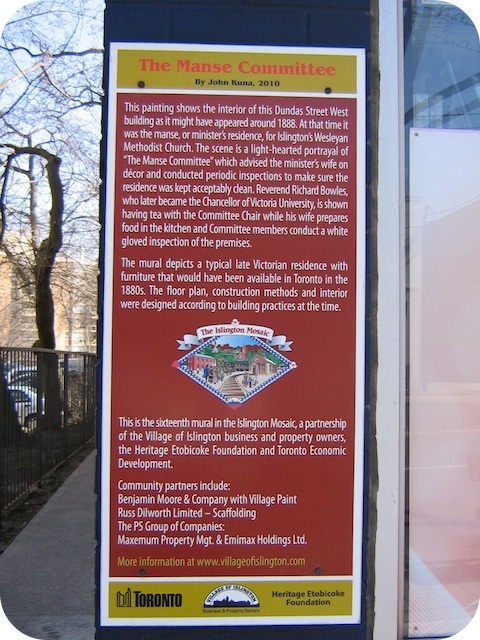
Photo by Alan L Brown - Posted March, 2012
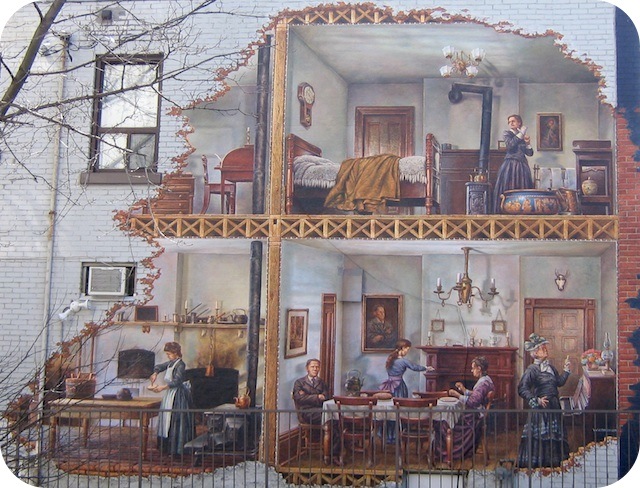
Photo by Alan L Brown - Posted March, 2012
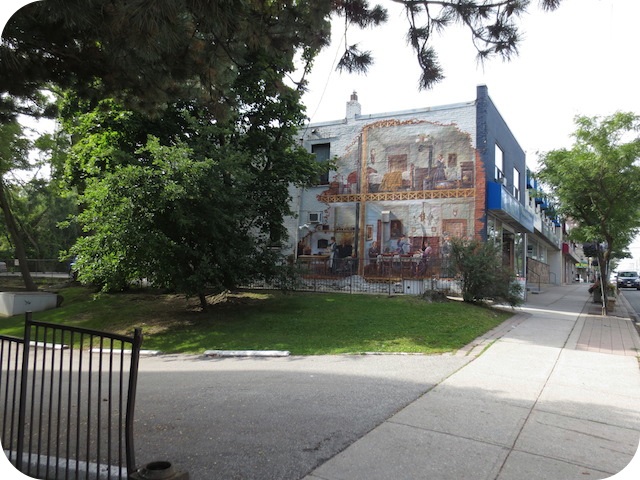
Photo by Alan L Brown - Posted August, 2014
This Village of Islington mural, titled "The Manse Committee" and painted in 2010 by John Kuna at 4879 Dundas Street West, depicts a typical late Victorian residence. Here's what the plaque tells us:
Coordinates: 43.64941 -79.52792 |
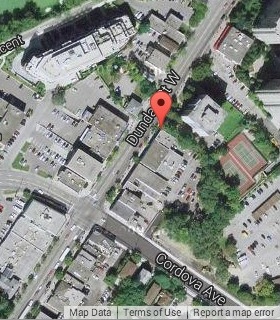 |
This painting shows the interior of this Dundas Street West building as it might have appeared around 1888. At that time it was the manse, or minister's residence, for Islington's Wesleyan Methodist Church. The scene is a light-hearted portrayal of "The Manse Committee" which advised the minister's wife on décor and conducted periodic inspections to make sure the residence was kept acceptably clean. Reverend Richard Bowles, who later became the Chancellor of Victoria University, is shown having tea with the Committee Chair while his wife prepares food in the kitchen and Committee members conduct a white gloved inspection of the premises.
The mural depicts a typical late Victorian residence with furniture that would have been available in Toronto in the 1880s. The floor plan, construction methods and interior were designed according to building practices at the time.
Related webpages
Wesleyan Methodist Church
Victoria University
Victorian residence
Return to list of murals
Portraits From Our Past
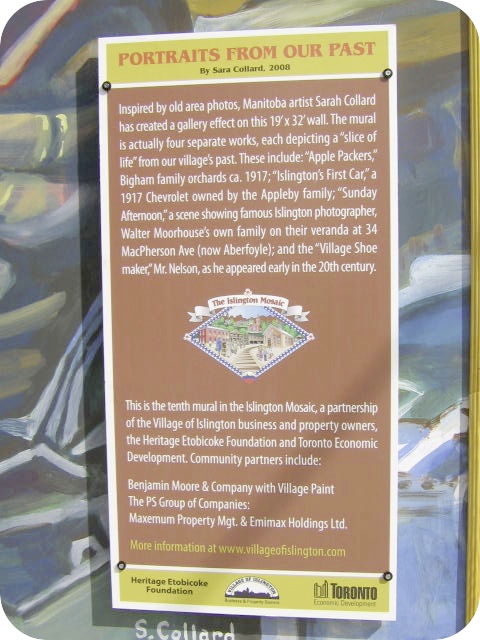
Photos by Alan L Brown - Posted October, 2008
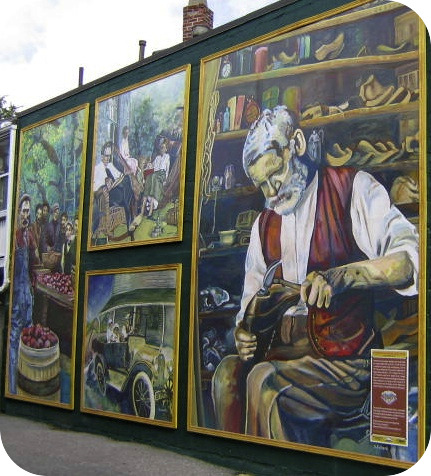
By artist Sara Collard 2008, this Village of Islington mural, titled Portraits From Our Past, is located on the west wall of the building at 4886 Dundas Street West. The accompanying plaque for this mural says:
Coordinates: 43.64953 -79.52821 |
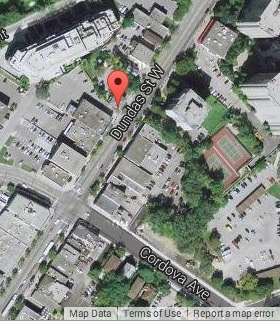 |
Inspired by old area photos, Manitoba artist Sarah Collard has created a gallery effect on this 6 m by 10 m wall. The mural is actually four separate works, each depicting a "slice of life" from our village's past. These include: "Apple Packers", Bigham family orchards ca. 1917; "Islington's First Car", a 1917 Chevrolet owned by the Appleby family; "Sunday Afternoon", a scene showing famous Islington photographer, Walter Moorhouse's own family on their veranda at 34 MacPherson Ave (now Aberfoyle); and the "Village Shoemaker", Mr. Nelson, as he appeared early in the 20th century.
Related webpages
Sarah Collard
Walter Moorhouse
Return to list of murals
Faith of Our Fathers, 2
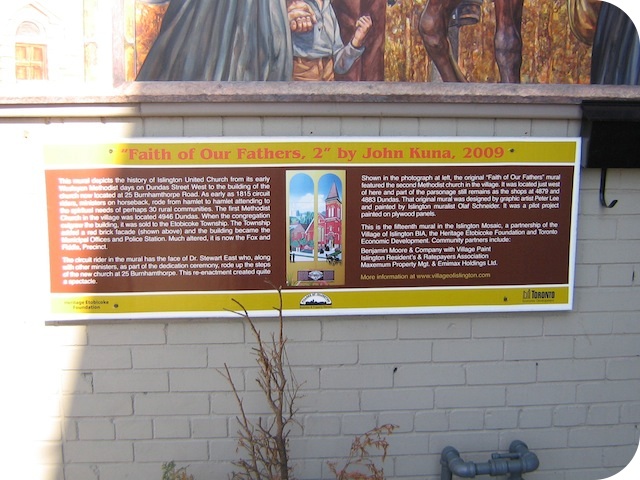
Photos by Alan L Brown - Posted December, 2009
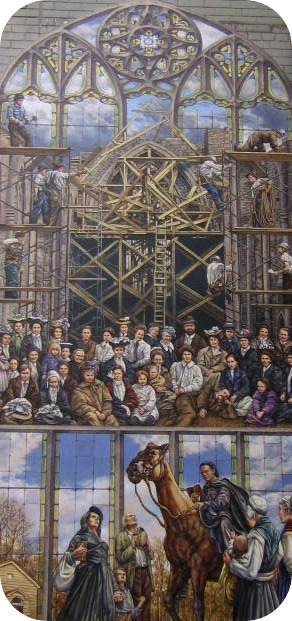
This Village of Islington mural Faith of Our Fathers, 2, overlooks 4901 Dundas Street West. It was painted in 2009 by John Kuna. The accompanying plaque for it says:
Coordinates: 43.64896 -79.52832 |
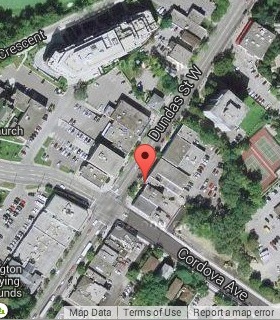 |
This mural depicts the history of Islington United Church from its early Wesleyan Methodist days on Dundas Street West to the building of the church now located at 25 Burnhamthorpe Road. As early as 1815 circuit riders, ministers on horseback, rode from hamlet to hamlet attending to the spiritual needs of perhaps 30 rural communities. The first Methodist Church in the village was located at 4946 Dundas. When the congregation outgrew the building, it was sold to the Etobicoke Township. The Township added a red brick façade (shown above) and the building became the Municipal Offices and Police Station. Much altered, it is now the Fox and Fiddle, Precinct.
The circuit rider in the mural has the face of Dr. Stewart East who, along with other ministers, as part of the dedication ceremony, rode up the steps of the new church at 25 Burnhampthorpe. This re-enactment created quite a spectacle.
Related webpages
Islington United Church
Methodism
Dundas Street
Islington
Return to list of murals
Battersby's March, 1813
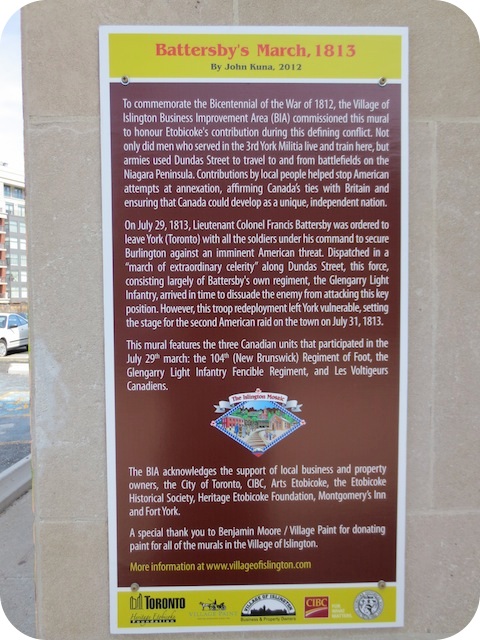
Photos by Alan L Brown - Posted May, 2013
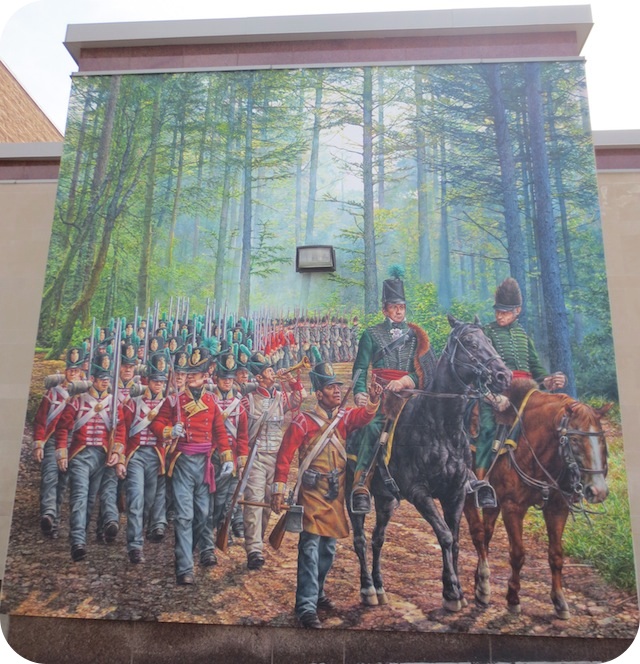
This Village of Islington mural, titled Battersby's March, can be found on the back wall of the CIBC building at 4914 Dundas Street West on the northeast corner of Dundas Street West and Burnhamthorpe Road. It was painted in 2012 by John Kuna. The mural features the three Canadian units that participated in the march: the 104th (New Brunswick) Regiment of Foot, the Glengarry Light Infantry Fencible Regiment, and Les Voltigeurs Canadiens. The accompanying plaque for this mural says:
Coordinates: 43.64907 -79.52899 |
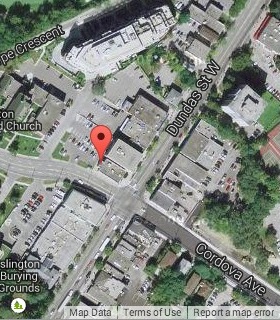 |
On July 29, 1813, Lieutenant Colonel Francis Battersby was ordered to leave York (Toronto) with all the soldiers under his command to secure Burlington against an imminent American threat. Dispatched in a "march of extraordinary celerity" along Dundas Street, this force, consisting largely of Battersby's own regiment, the Glengarry Light Infantry, arrived in time to dissuade the enemy from attacking this key position. However, this troop redeployment left York vulnerable, setting the stage for the second American raid on the town on July 31, 1813.
Related webpages
Francis Battersby
Glengarry Light Infantry
Related Toronto plaque
The Second Invasion of York 1813
Related Ontario plaque
Burlington Heights 1813-1814
Return to list of murals
The Faces of Islington
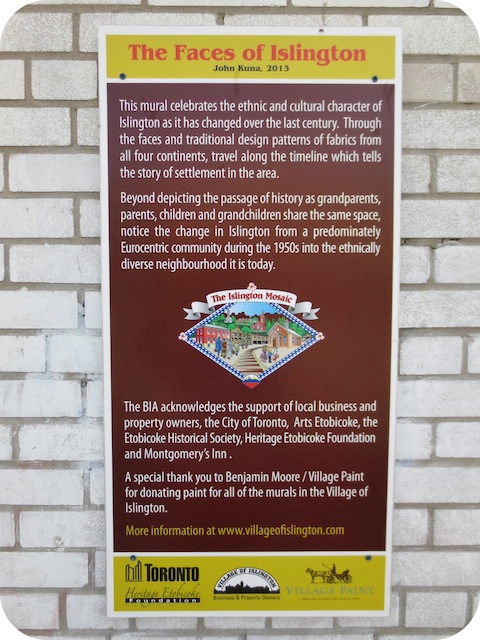
Photos by Alan L Brown - Posted June 30, 2014

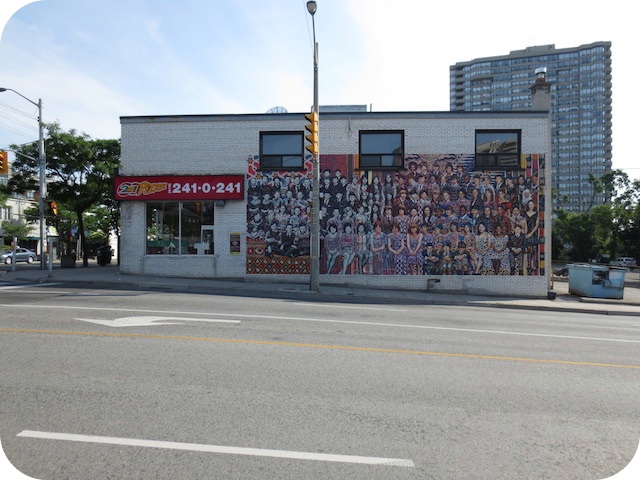
This Village of Islington mural, titled The Faces of Islington, can be found on the southeast corner of Dundas Street West and Cordova Avenue. It was painted in 2013 by John Kuna on the wall facing Cordova Avenue. The accompanying plaque for this mural says:
Coordinates: 43.64876 -79.52839 |
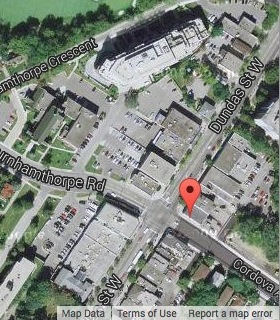 |
This mural celebrates the ethnic and cultural character of Islington as it has changed over the last century. Through the faces and traditional design patterns of fabrics from all four continents, travel along the timeline which tells the story of settlement in the area.
Beyond depicting the passage of history as grandparents, parents, children and grandchildren share the same space, notice the change in Islington from a predominantly Eurocentric community during the 1950s into the ethnically diverse neighbourhood it is today.
Return to list of murals
Briarly - Gone But Not Forgotten
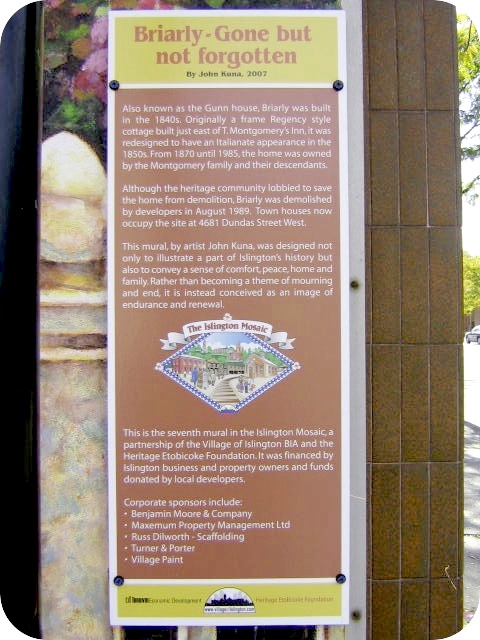
Photos by Alan L Brown - Posted April, 2008
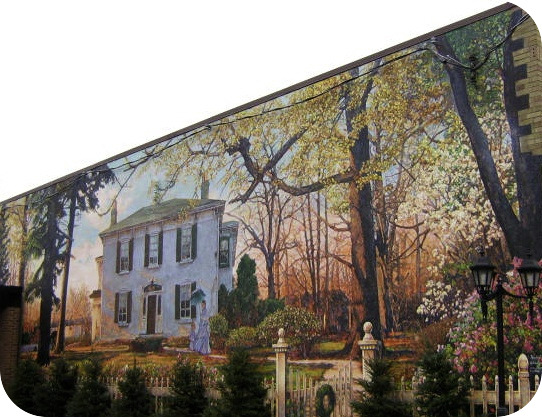
Painted in Post Impressionist style, this Village of Islington mural, titled Briarly - Gone But Not Forgotten, faces 4937 Dundas Street West. It was painted in 2007 by John Kuna. The accompanying plaque for this mural says:
Coordinates: 43.64802 -79.52920 |
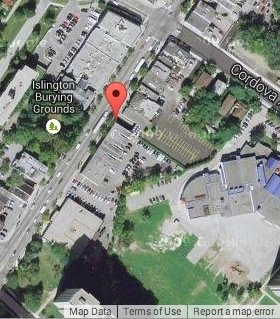 |
Also known as the Gunn house, Briarly was built in the 1840s. Originally a frame Regency style cottage built just east of T. Montgomery's Inn, it was redesigned to have an Italianate appearance in the 1850s. From 1970 until 1985, the home was owned by the Montgomery family and their descendants.
Although the heritage community lobbied to save the home from demolition, Briarly was demolished by developers in August 1989. Town houses now occupy the site at 4681 Dundas Street West.
This mural, by artist John Kuna was designed not only to illustrate a part of Islington's history but also to convey a sense of comfort, peace, home and family. Rather than becoming a theme of mourning and end, it is instead conceived as an image of endurance and renewal.
Related webpages
Regency architecture
Italianate architecture
Related Toronto plaque
Montgomery's Inn
Return to list of murals
The Pub With No Beer
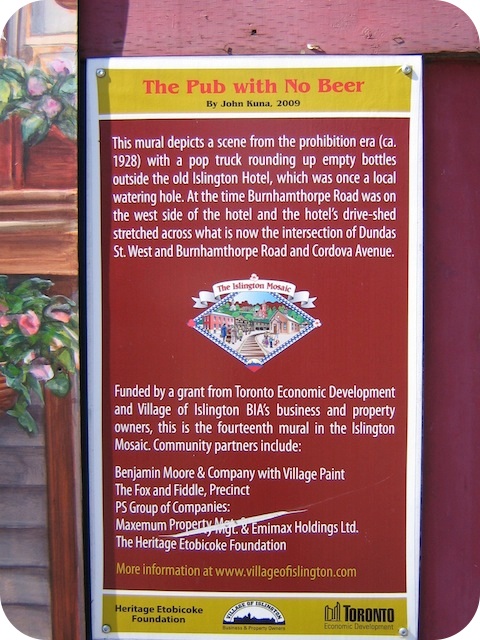
Photos by Alan L Brown - Posted December, 2009
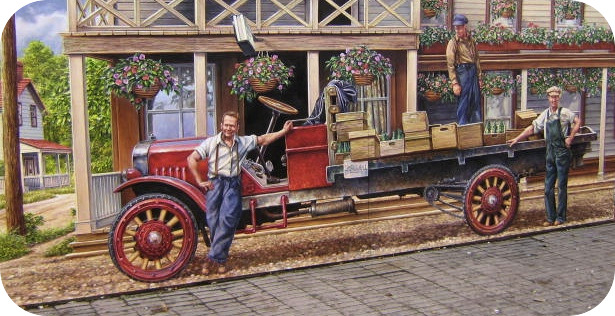
Located at 4946 Dundas Street West is this Village of Islington mural, titled The Pub with No Beer, by John Kuna, 2009. The accompanying plaque for this mural says:
Coordinates: 43.64814 -79.52947 |
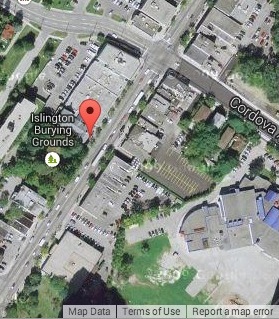 |
|
This mural depicts a scene from the prohibition era (ca. 1928) with a pop truck rounding up empty bottles outside of the old Islington Hotel, which was once a local watering hole. At the time Burnhamthorpe Road was on the west side of the hotel and the hotel's drive-shed stretched across what is now the intersection of Dundas St. West and Burnhamthorpe Road and Cordova Avenue.
Related webpages
prohibition era
Return to list of murals
Timeline, Islington Then and Now
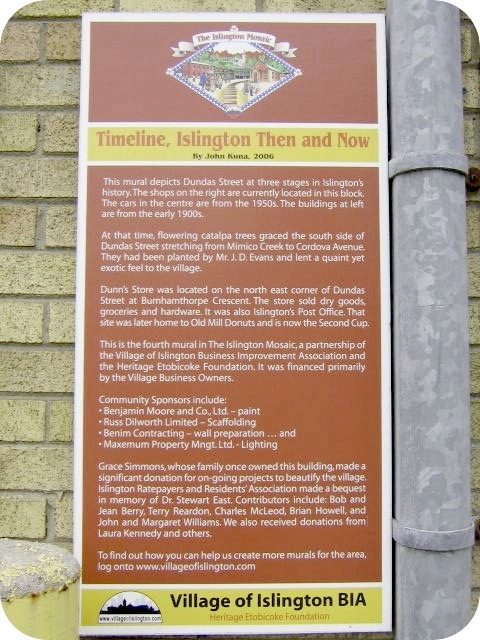
Photos by Alan L Brown - Posted August, 2007

Located at 4959 Dundas Street West, is this Village of Islington mural titled Timeline, Islington Then and Now by John Kuna, 2006. The accompanying plaque for this mural says:
Coordinates: 43.64760 -79.52959 |
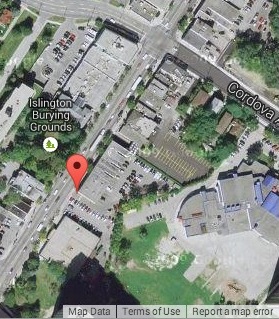 |
This mural depicts Dundas Street at three stages in Islington's history. The shops on the right are currently located in this block. The cars in the centre are from the 1950s. The buildings at left are from the early 1900s.
At that time, flowering catalpa trees graced the south side of Dundas Street stretching from Mimico Creek to Cordova Avenue. They had been planted by Mr. J.D. Evans and lent a quaint yet exotic feel to the village.
Dunn's Store was located on the north east corner of Dundas Street at Burnhamthorpe Crescent. The store sold dry goods, groceries and hardware. It was also Islington's Post Office. That site was later home to Old Mill Donuts and is now the Second Cup.
Related webpages
Mimico Creek
flowering catalpa trees
Return to list of murals
Gordon's Dairy, ca. 1940
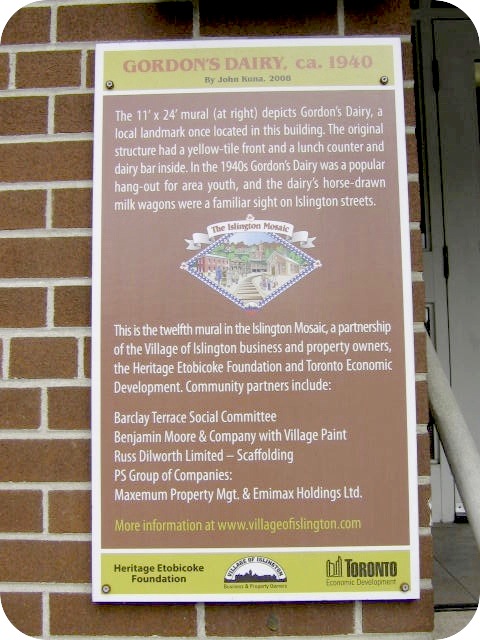
Photos by Alan L Brown - Posted July, 2009
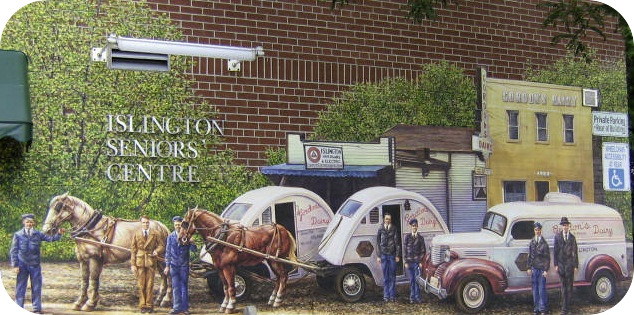
Located at 4968 Dundas Street West, just west of the Islington Burying Grounds, this Village of Islington mural, titled Gordon's Dairy, ca. 1940, was painted by John Kuna in 2008. The accompanying plaque for this mural says:
Coordinates: 43.64764 -79.52993 |
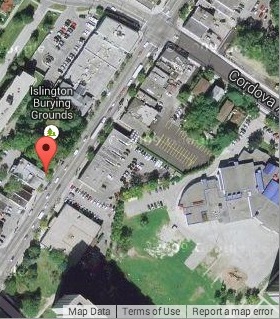 |
The 3.3 m x 7.3 m mural (at right) depicts Gordon's Dairy, a local landmark once located in this building. The original structure had a yellow-tile front and a lunch counter and diary bar inside. In the 1940s Gordon's Dairy was a popular hang-out for area youth, and the dairy's horse-drawn milk wagons were a familiar sight on Islington streets.
Return to list of murals
Ordinary Folk, Extraordinary Lives
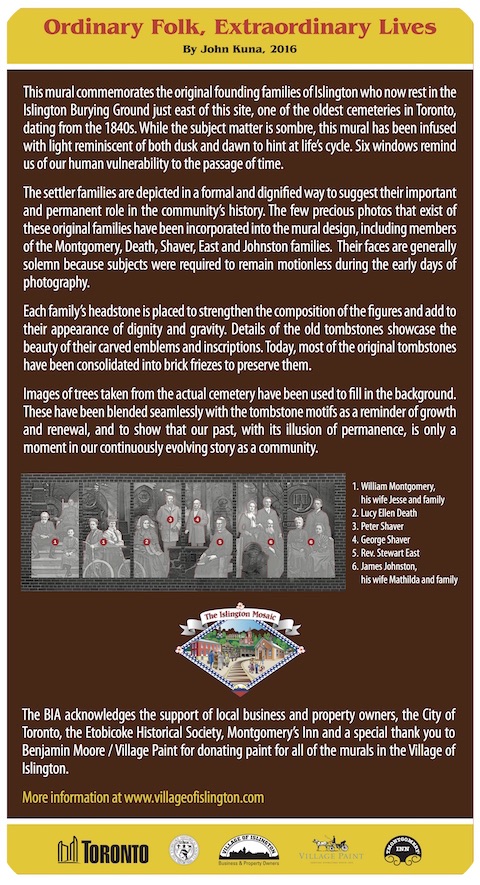
Photos courtesy of the Village of Islington BIA - Posted May, 2016
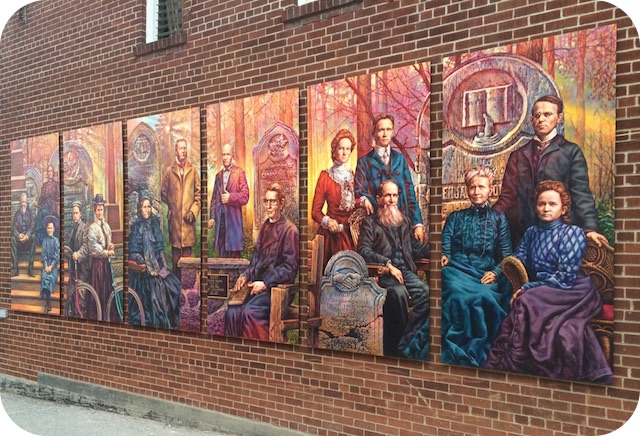
Located at 4970 Dundas Street West, west of the Islington Burying Grounds, this Village of Islington mural, titled Ordinary Folk, Extraordinary Lives, was painted by John Kuna in 2016. The accompanying plaque for this mural says:
Coordinates: 43.647508 -79.530149 |
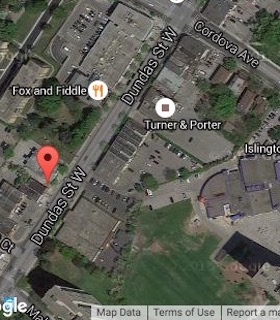 |
This mural commemorates the original founding families of Islington who now rest in the Islington Burying Ground just east of this site, one of the oldest cemeteries in Toronto, dating from the 1840s. While the subject matter is somber, this mural has been infused with light reminiscent of both dusk and dawn to hint at life's cycle. Six windows remind us of our human vulnerability to the passage of time.
The settler families are depicted in a formal and dignified way to suggest their important and permanent role in the community's history. The few precious photos that exist of these original families have been incorporated into the mural design, including members of the Montgomery, Death, Shaver, East and Johnston families. Their faces are generally solemn because subjects were required to remain motionless during the early days of photography.
Each family's headstone is placed to strengthen the composition of the figures and add to their appearance of dignity and gravity. Details of the old tombstones showcase the beauty of their carved emblems and inscriptions. Today, most of the original tombstones have been consolidated into brick friezes to preserve them.
Images of trees taken from the actual cemetery have been used to fill in the background. These have been blended seamlessly with the tombstone motifs as a reminder of growth and renewal, and to show that our past, with its inclusion of permanence, is only a moment in our continuously evolving story as a community.
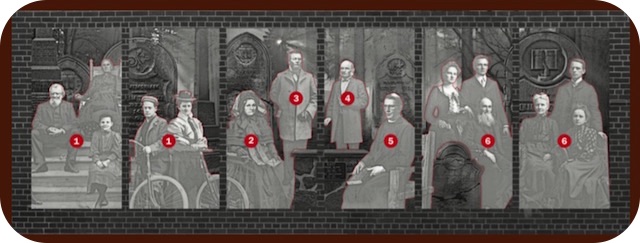 1. William Montgomery, his wife Jesse and family
1. William Montgomery, his wife Jesse and family
2. Lucy Ellen Death
3. Peter Shaver
4. George Shaver
5. Rev. Stewart East
6. James Johnston, his wife Mathilda and family
Related webpage
Islington Burying Ground
Return to list of murals
The Way We Were - Islington ca 1900
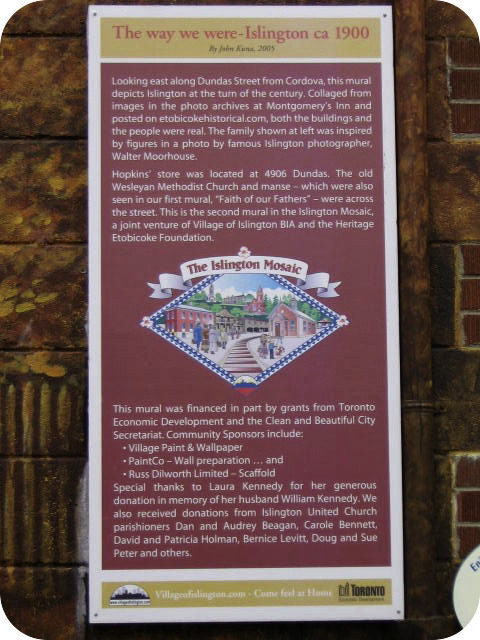
Photos by Alan L Brown - Posted June, 2006
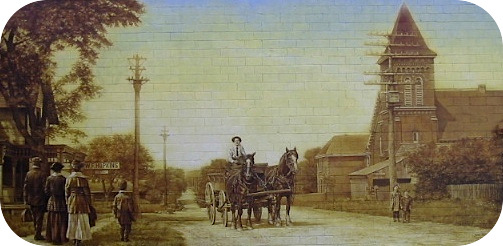
Painted in photographic representational style, this Village of Islington mural, titled The way we were - Islington ca 1900, is part of a unique, historical diorama located at 4972 Dundas Street West. It was painted in 2005 by Toronto artist, John Kuna. The accompanying plaque for this mural says:
Coordinates: 43.64740 -79.53020 |
 |
Looking east along Dundas Street from Cordova, this mural depicts Islington at the turn of the century. Collaged from images in the photo archives at Montgomery's Inn and posted on etobicokehistorical.com, both the buildings and the people were real. The family shown at left was inspired by figures in a photo by famous Islington photographer, Walter Moorhouse.
Hopkins' store was located at 4906 Dundas. The old Wesleyan Methodist Church and manse - which were also seen in our first mural, "Faith of our Fathers" - were across the street.
Related webpage
etobicokehistorical.com
Walter Moorhouse
Wesleyan Methodist Church
Related Toronto plaque
Montgomery's Inn
Return to list of murals
Islington - The Way We Were - Part II
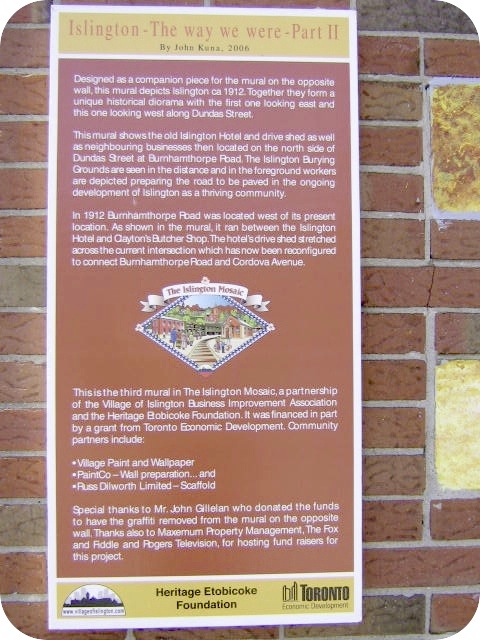
Photos by Alan L Brown - Posted August, 2007
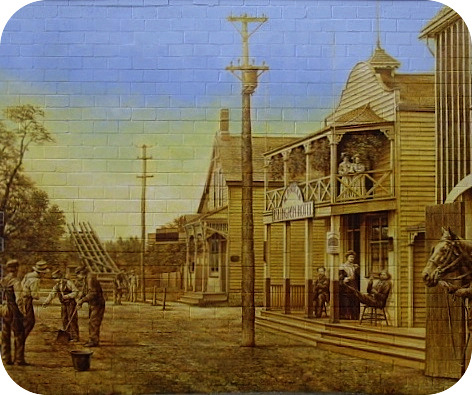
Located at 4984 Dundas Street West, this Village of Islington mural, titled Islington - The way we were - Part II was painted by John Kuna in 2006. The accompanying plaque for this mural says:
Coordinates: 43.647221 -79.530392 |
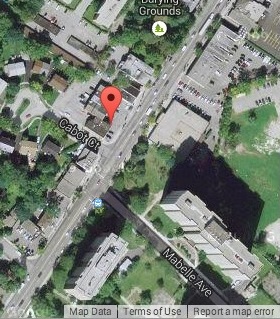 |
Designed as a companion piece for the mural on the opposite wall, this mural depicts Islington ca 1912. Together they form a unique historical diorama with the first one looking east and this one looking west along Dundas Street.
This mural shows the old Islington Hotel and drive shed as well as neighbouring shops then located on the north side of Dundas Street at Burnhamthorpe Road. The Islington Burying Grounds are seen in the distance and in the foreground workers are depicted preparing the road to be paved in the ongoing development of Islington as a thriving community.
In 1912 Burnhamthorpe Road was located west of its present location. As shown in the mural, it ran between the Islington Hotel and Clayton's Butcher Shop. The hotel's drive shed stretched across the current intersection which has now been reconfigured to connect Burnhamthorpe Road and Cordova Avenue.
Return to list of murals
Mimico Creek, ca. 1920
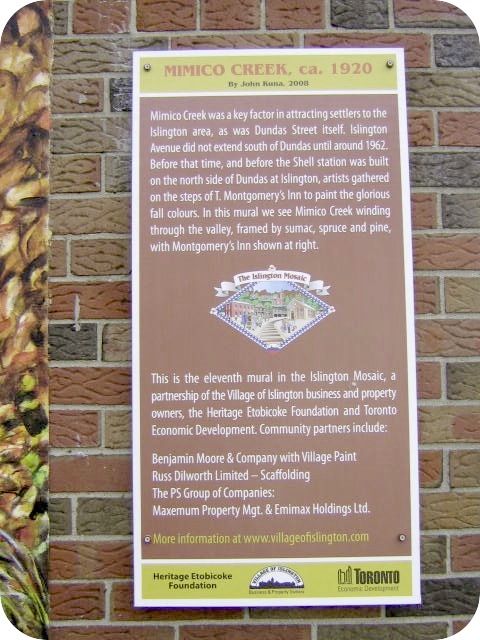
Photos by Alan L Brown - Posted July, 2009

This Village of Islington mural, titled Mimico Creek, ca. 1920, is located at 4986 Dundas Street West. It was painted in 2008 by Toronto artist, John Kuna. The accompanying plaque for this mural says:
Coordinates: 43.647120 -79.530486 |
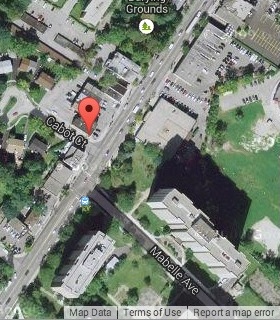 |
Mimico Creek was a key factor in attracting settlers to the Islington area, as was Dundas Street itself. Islington Avenue did not extend south of Dundas Street until around 1962. Before that time and before the Shell station was built on the north side of Dundas at Islington, artists gathered on the steps on T. Montgomery's Inn to paint the glorious fall colours. In this mural we see Mimico Creek winding through the valley, framed by sumac, spruce and pine, with Montgomery's Inn shown at right.
Related webpages
Mimico Creek
sumac
spruce
pine
Return to list of murals
Honouring Islington's Volunteer Fire Brigade
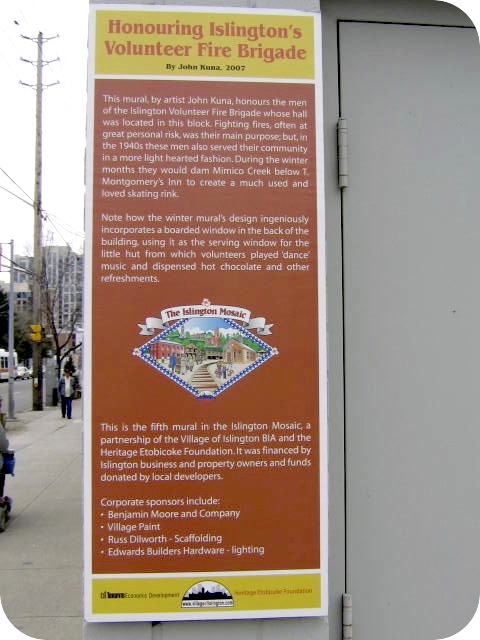
Photos by Alan L Brown - Posted April, 2008
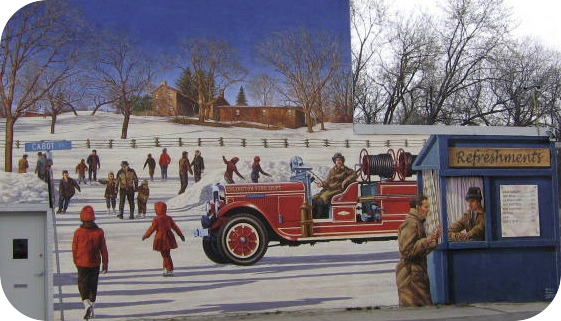
Located on the east wall of 4988 Dundas Street West, this Village of Islington mural, titled Honouring Islington's Volunteer Fire Brigade, was painted in 2007 by John Kuna. The accompanying plaque for this mural says:
Coordinates: 43.646999 -79.530537 |
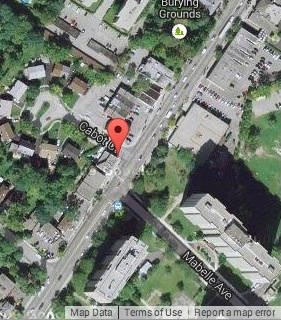 |
This mural, by artist John Kuna, honours the men of the Islington Volunteer Fire Brigade whose hall was located in this block. Fighting fires, often at great personal risk, was their main purpose; but in the 1940s these men also served their community in a more light hearted fashion. During the winter months they would dam Mimico Creek below T. Montgomery's Inn to create a much used and loved skating rink.
Note how the winter mural's design ingeniously incorporates a boarded window in the back of the building, using it as the serving window for the little hut from which volunteers played 'dance' music and dispensed hot chocolate and other refreshments.
Related webpage
Mimico Creek
Related Toronto plaque
Montgomery's Inn
Return to list of murals
Ontario Gothic
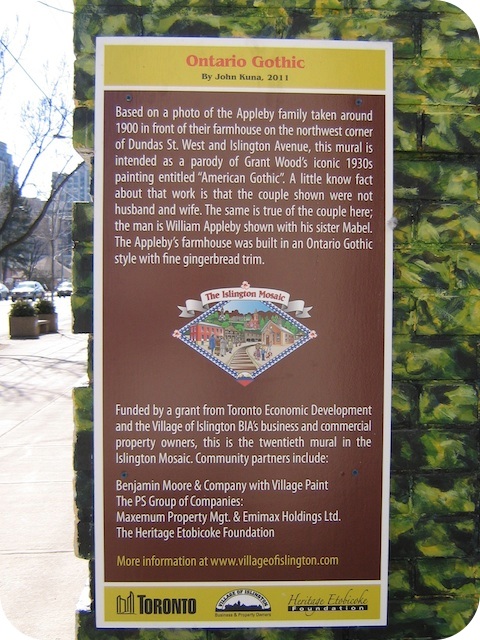
Photos by Alan L Brown - Posted March, 2012
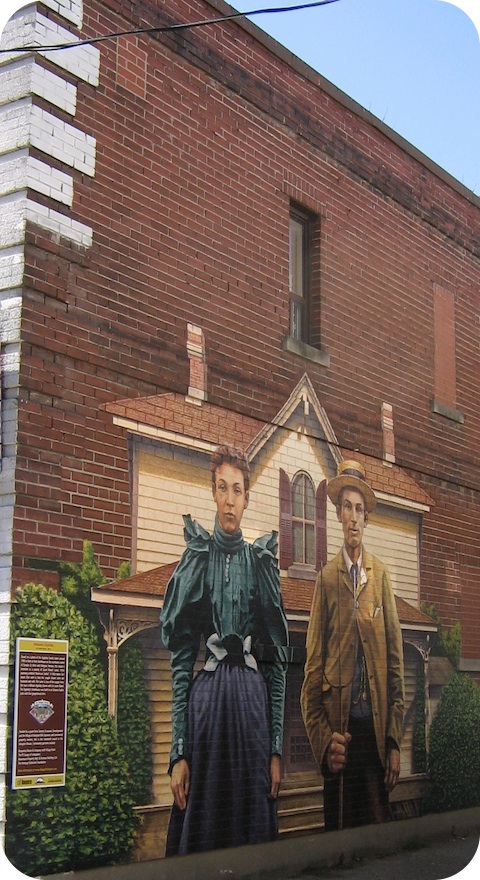
This Village of Islington mural, titled "Ontario Gothic" and painted in 2011 by John Kuna at 4990 Dundas Street West, depicts a farmhouse at Dundas and Islington. Here's what the plaque says:
Coordinates: 43.646852 -79.530663 |
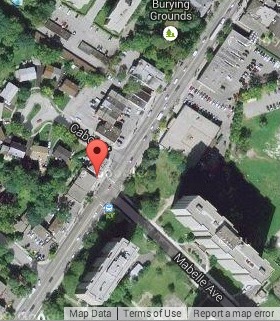 |
Based on a photo of the Appleby family taken around 1900 in front of their farmhouse on the northwest corner of Dundas St. West and Islington Avenue, this mural is intended as a parody of Grant Wood's iconic 1930s painting entitled "American Gothic". A little known fact about that work is that the couple shown were not husband and wife. The same is true of the couple here; the man is William Appleby shown with his sister Mabel. The Appleby's farmhouse was built in an Ontario Gothic style with fine gingerbread trim.
Related webpage
American Gothic
Return to list of murals
Harold G. Shipp's "First High Flier!"
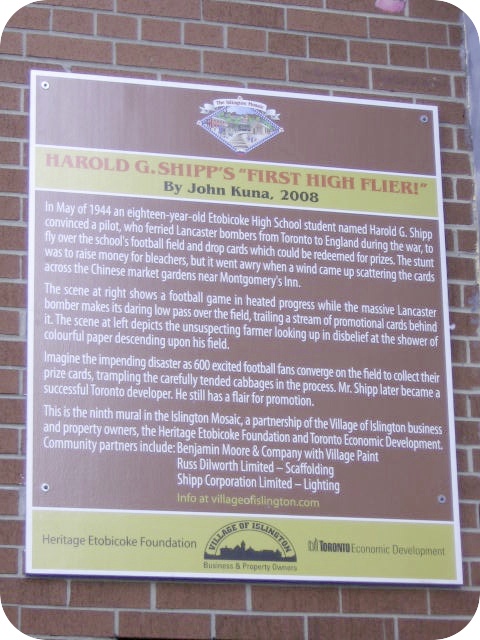
Photos by Alan L Brown - Posted April, 2008
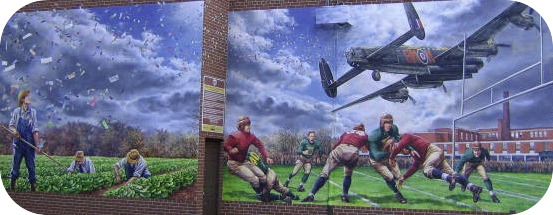
Photos by Alan L Brown - Posted October, 2008
By artist John Kunthis 2008, this Village of Islington mural, titled Harold G. Shipp's "First High Flier!", is located on the west wall of the building at 4994 Dundas Street West. The accompanying plaque for this mural says:
Coordinates: 43.646660 -79.530845 |
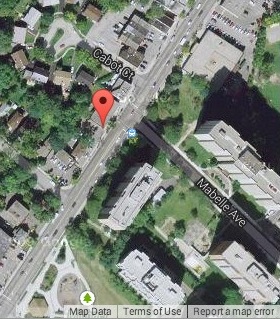 |
In May of 1944 an eighteen-year-old Etobicoke High School student named Harold G. Shipp convinced a pilot, who ferried Lancaster bombers from Toronto to England during the war, to fly over the school's football field and drop cards which could be redeemed for prizes. The stunt was to raise money for bleachers, but it went awry when a wind came up scattering the cards across the Chinese market gardens near Montgomery's Inn.
The scene at right shows a football game in heated progress while the massive Lancaster bomber makes its daring low pass over the field, trailing a stream of promotional cards behind it. The scene at left depicts the unsuspecting farmer looking up in disbelief at the shower of colourful paper descending upon his field.
Imagine the impending disaster as 600 excited football fans converge on the field to collect their prize cards, trampling the carefully tended cabbages in the process. Mr. Shipp later became a successful Toronto developer. He still has a flair for promotion.
Related webpages
Etobicoke High School
Lancaster bombers
market gardens
Related Toronto plaque
Montgomery's Inn
Return to list of murals
Prodigy
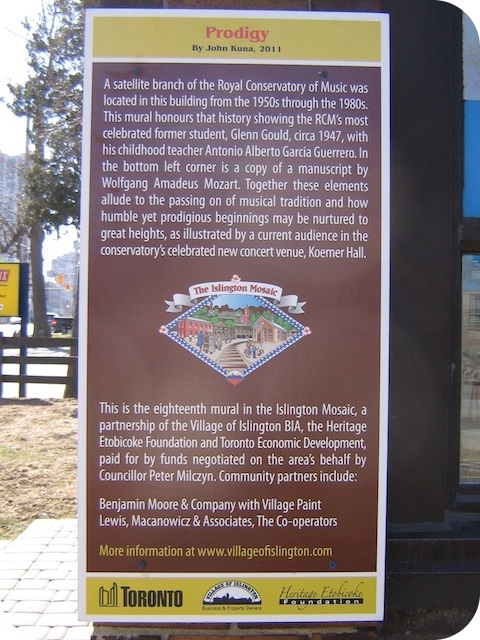
Photos by Alan L Brown - Posted March, 2012

This Village of Islington mural, titled "Prodigy" and painted in 2011 by John Kuna at 5048 Dundas Street West, depicts Glen Gould at the piano. Here's what the plaque says:
Coordinates: 43.646054 -79.531403 |
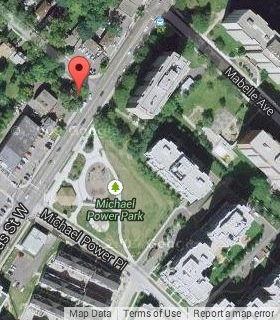 |
A satellite branch of the Royal Conservatory of Music was located in this building from the 1950s through the 1980s. This mural honours that history showing the RCM's most celebrated former student Glenn Gould, circa 1947, with his childhood teacher Antonio Alberto Garcia Guerrero. In the bottom left corner is a copy of a manuscript by Wolfgang Amadeus Mozart. Together these elements allude to the passing on of musical tradition and how humble yet prodigious beginnings may be nurtured to great heights, as illustrated by a current audience in the conservatory's celebrated new concert venue, Koerner Hall.
Related webpages
Royal Conservatory of Music
Antonio Alberto Garcia Guerrero
Wolfgang Amadeus Mozart
Related Toronto plaque
Glenn Gould
Return to list of murals
Fishing in Mimico Creek
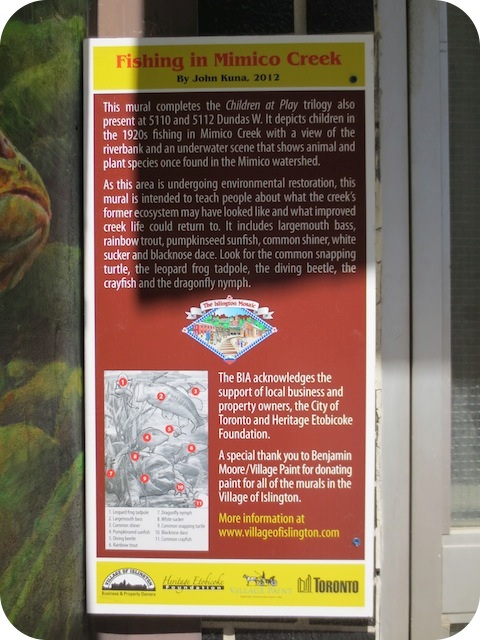
Photos by Alan L Brown - Posted March, 2012
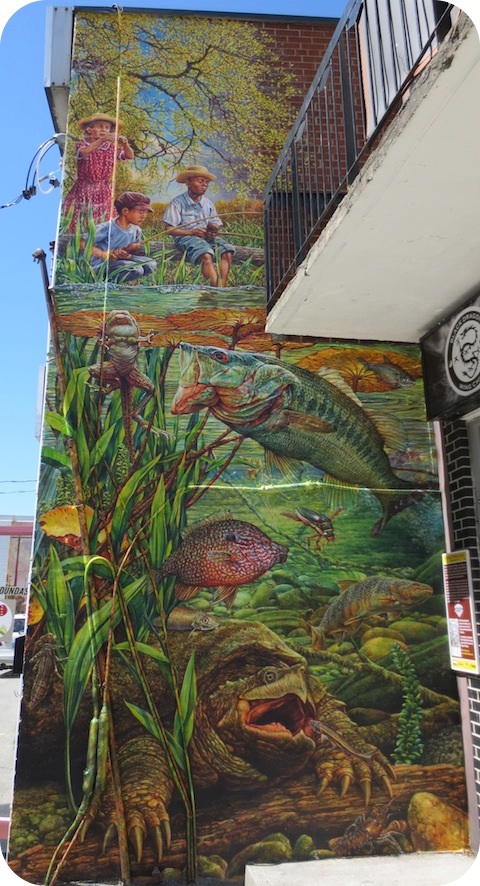
This Village of Islington mural, titled "Fishing in Mimico Creek" and painted in 2012 by John Kuna at 5096 Dundas Street West, depicts fishing in Mimico Creek. Here's what the plaque says:
Coordinates: 43.644958 -79.532586 |
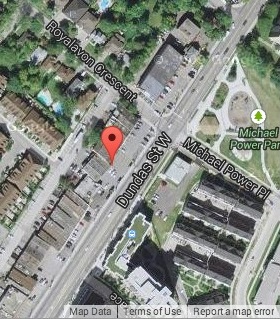 |
This mural completes the Children at Play trilogy also present on Riding the Radials at 5110 and on Toboggan Hill at 5112 Dundas W. It depicts children in the 1920s fishing in Mimico Creek with a view of the riverbank and an underwater scene that shows animal and plant species once found in the Mimico watershed.
As this area is undergoing environmental restoration, this mural is intended to educate what the creek's former ecosystem may have looked like and what improved creek life could return to. It includes largemouth bass, rainbow trout, pumpkinseed sunfish, common shiner, white sucker and blacknose dace. Look for the common snapping turtle, the leopard frog tadpole, the diving beetle, the crayfish and the dragonfly nymph.
Related webpages
Mimico Creek
ecosystem
largemouth bass
rainbow trout
pumpkinseed sunfish
common shiner
white sucker
blacknose dace
common snapping turtle
leopard frog tadpole
diving beetle
crayfish
dragonfly nymph
Return to list of murals
Riding the Radials
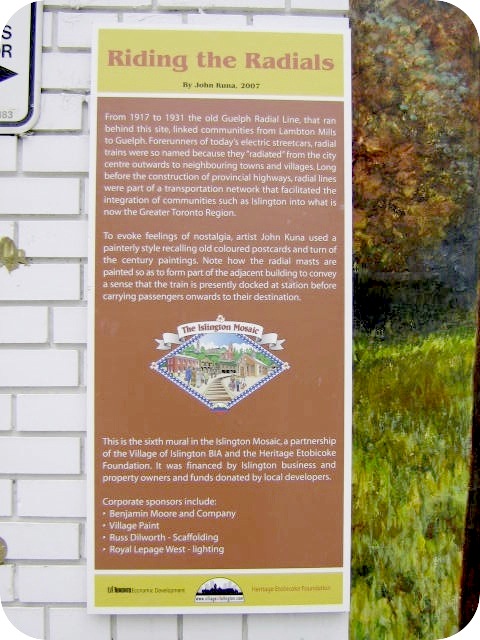
Photos by Alan L Brown - Posted April, 2008
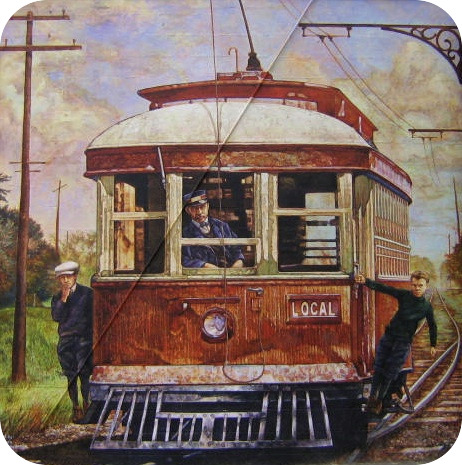
By artist John Kunthis 2007, this Village of Islington mural, titled Riding the Radials, is located on the east wall of the building at 5110 Dundas Street West. The accompanying plaque for this mural says:
Coordinates: 43.644802 -79.532696 |
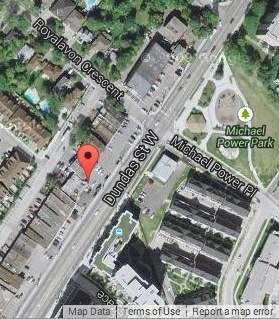 |
From 1917 to 1931 the old Guelph Radial Line, that ran behind this site, linked communities from Lambton Mills to Guelph. Forerunners of today's electric streetcars, radial trains were so named because they "radiated" from the city centre outwards to neighbouring towns and villages. Long before the construction of provincial highways, radial lines were part of a transportation network that facilitated the integration of communities such as Islington into what is now the Greater Toronto Region.
To evoke feelings of nostalgia, artist John Kuna used a painterly style recalling old coloured postcards and turn of the century paintings. Note how the radial masts are painted so as to form part of the adjacent building to convey a sense that the train is presently docked at station before carrying passengers onwards to their destination.
Related webpages
Guelph Radial Line
Lambton Mills
Related Ontario plaque
Toronto's Radial Railways
Return to list of murals
Toboggan Hill
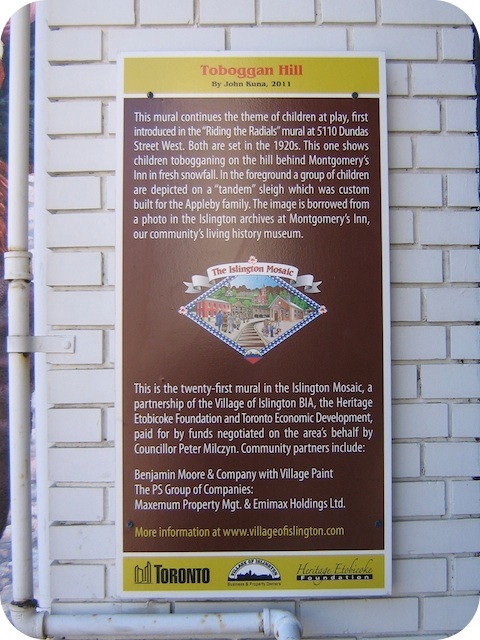
Photos by Alan L Brown - Posted March, 2012
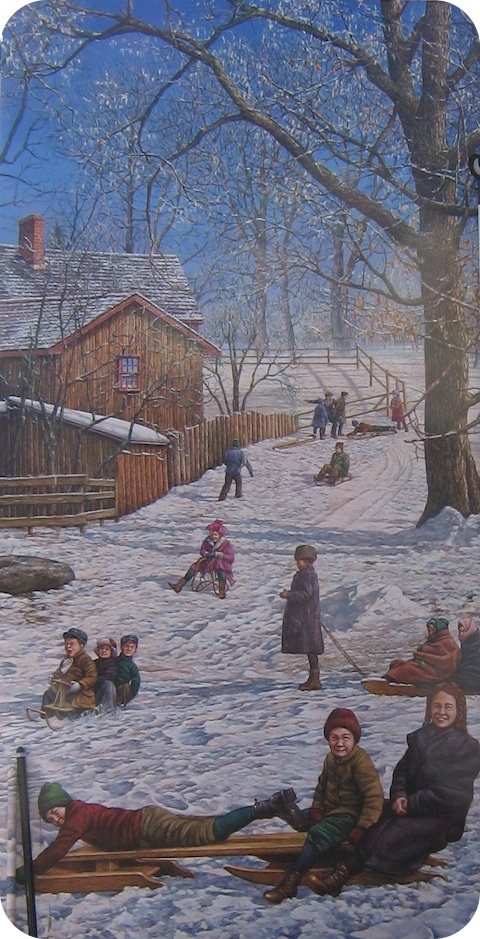
This Village of Islington mural, titled "Toboggan Hill" and painted in 2011 by John Kuna at 5112 Dundas Street West, depicts children playing in winter. Here's what the plaque tells us:
Coordinates: 43.644651 -79.532819 |
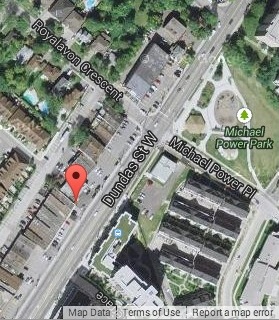 |
This mural continues the theme of children at play, first introduced in the "Riding the Radials" mural at 5110 Dundas Street West. Both are set in the 1920s. This one shows children tobogganing on the hill behind Montgomery's Inn in fresh snowfall. In the foreground a group of children are depicted on a "tandem" sleigh which was custom built for the Appleby family. The image is borrowed from a photo in the Islington archives at Montgomery's Inn, our community's living history museum.
Related webpage
tobogganing
Related Toronto plaque
Montgomery's Inn
Return to list of murals
The Old Swimming Hole
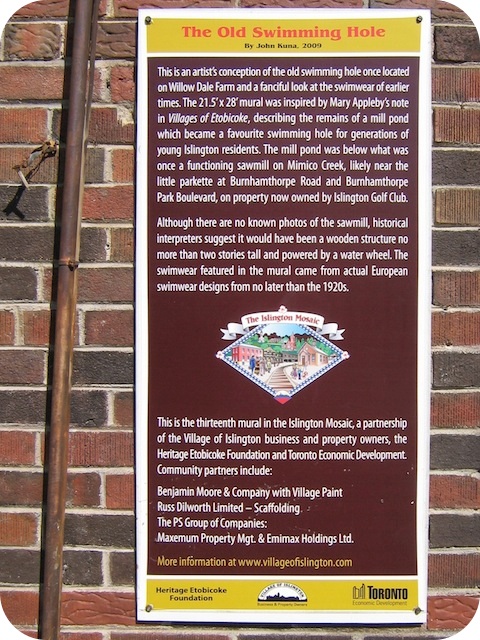
Photos by Alan L Brown - Posted December, 2009
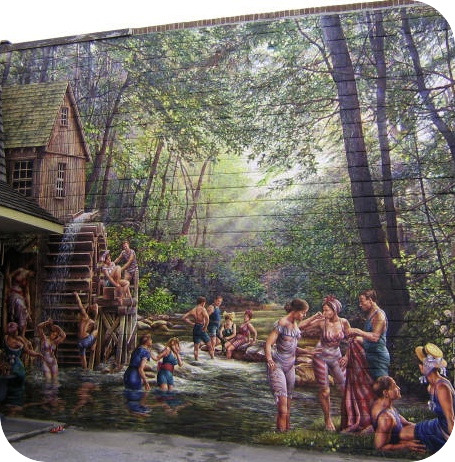
By artist John Kunthis 2009, this Village of Islington mural, titled The Old Swimming Hole, is located west wall of 5126 Dundas St West. The accompanying plaque for this mural says:
Coordinates: 43.644290 -79.533163 |
 |
This is an artist's conception of the old swimming hole once located on Willow Dale Farm and a fanciful look at the swimwear of earlier times. The 6.5 m x 8.5 m mural was inspired by Mary Appleby's note in Villages of Etobicoke, describing the remains of a mill pond which became a favourite swimming hole for generations of young Islington residents. The mill pond was below what was once a functioning sawmill on Mimico Creek, likely near the little parkette at Burnhamthorpe Road and Burnhamthorpe Park Boulevard, on property now owned by Islington Golf Club.
Although there are no known photos of the sawmill, historical interpreters suggest it would have been a wooden structure no more than two stories tall and powered by a water wheel. The swimwear featured in the mural came from actual European swimwear designs from no later than the 1920s.
Related webpages
swimwear of earlier times
sawmill
Mimico Creek
Islington Golf Club
More mural plaques
A Bit of England Far From England
Etobicoke Transportation Mural
Toronto's Reggae Roots
History As Theatre: 200 Toronto Years
More
Neighbourhoods, Villages and Towns
Here are the visitors' comments for this page.
> Posted June 16, 2009
It is fascinating to get a peek into life as it was at various times in the history of Islington Village. I attempt to connect the historic views, activities, building and road locations with our present time and uses. Apart from appreciating the history of and reviving the neighbourhood, these murals are just plain enjoyable to look at.
Cheryl Mullock
> Posted December 26, 2008
Hello. As someone who spent many wonderful hours at the Central Park Skating Rink in the 1940s ans 1950s, I am wondering if anyone could help me locate a photograph of the rink with the hut built by the Kingsway Kiwanis Club in 1946. I am also looking for a set of the Max Boag and the Skaters Band played at this popular up until 1957. Please email at [email protected]. Thank you!
> Posted December 1, 2008
The way you have displayed Islington's murals, with the plaques and little maps is just excellent. Your photos are beautiful, too. You have gone to a lot of trouble to promote Toronto's emerging Mural Town. Thank you very much for your interest.
Linda Pedersen for the Islington Mosaic, Village of Islington - Village of Murals
> Posted September 13, 2008
I love them! The murals are an outstanding addition to the streetscape, gracing a jumble of undeserving old retail strip malls and new condo development. Here's hoping that their presence will elevate the area and encourage stores and new businesses that better deserve this artistic installation (while maintaining the buildings that contain the murals!). It deserves to be more widely appreciated.
Kudos to the local business community that supports this, and to John Kuna for imaginative and impressive murals. It is on our tour for all visitors.
Here's where you can send me a comment for this page.
Note: Your email address will be posted at the end of your comment so others can respond to you unless you request otherwise.
Note: Comments are moderated. Yours will appear on this page within 24 hours (usually much sooner).
Note: As soon as I have posted your comment, a reply to your email will be sent informing you.
To send me your comment, click [email protected].
Thanks
Webmaster
Note: If you wish to send me a personal email, click here.